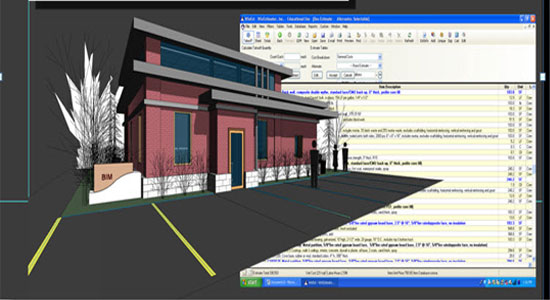The foundation for a successful estimate depends on authentic takeoff of the quantities of the various materials involved in the project. The various elements that lead to an effective cost estimate are as:
Labor Rates: The labor rate or wage is the cost per hour for the craftsmen on the project. To determine any craft rate, whether union or open shop, the estimator should start with the basic wages and fringe benefits. The estimator should include payroll burdens to the wages and fringe benefits. These are FICA (Social Security), SUI (State Unemployment Insurance), FUI (Federal Unemployment Insurance), WC (Worker Compensation) and others mandated by legislation and/or company operations. These burdens, along with the base wages and fringe benefits, determine the hourly cost of a craft classification which includes carpenter, pipefitter, etc.
The hourly rate can also include an amalgamated crew where different crafts are required for the performance of the work. Overtime or the lack of overtime is another factor that determines the calculation of the hourly rates. A project that is scheduled for completion using a forty hour work week will have a modest amount of overtime costs needed in the estimate. A project that is scheduled for extended 50, 60 or 70 hour work weeks will have a substantial amount included for overtime and loss of productivity.
Material Prices: Material prices fluctuate up and down every now and then and it is important that the estimator understands as well as anticipates the frequency and extent of the price variations and the timing of the buying cycle. Material prices can be affected by:
Equipment Costs: Equipment rates depend on the project conditions to decide on the accurate size or capacity of equipment necessary to execute the work. When interfacing with other equipment, cycle times and equipment capacity control the costs on the project. Costs also vary if the equipment is owned by the contractor and not rented.
Indirect Costs: Indirect costs consist of labor, material, and equipment items that are necessary to support the overall project.
For the owner: Design fees, permits, land acquisition costs, legal fees, administration costs, etc.
For the contractor and subcontractor: Mobilization, staffing, on-site job office, temporary construction, temporary heat/cooling, and temporary utilities, equipment, small tools and consumables, etc.
Profit Amount: Appropriate or contracted profit rate should be applied uniformly to all contractors and to original bid and change orders.

Labor Hours: Labor hour amounts can be prepared by crew analysis or applied on a unit man-hour basis. The use of a labor dollar per unit of work is only applicable when the cost history supports the data that is being used. The estimator should make allowance for the varying production capability that occurs on the basis of the complexity of a project.
Labor Rates: The labor rate or wage is the cost per hour for the craftsmen on the project. To determine any craft rate, whether union or open shop, the estimator should start with the basic wages and fringe benefits. The estimator should include payroll burdens to the wages and fringe benefits. These are FICA (Social Security), SUI (State Unemployment Insurance), FUI (Federal Unemployment Insurance), WC (Worker Compensation) and others mandated by legislation and/or company operations. These burdens, along with the base wages and fringe benefits, determine the hourly cost of a craft classification which includes carpenter, pipefitter, etc.
The hourly rate can also include an amalgamated crew where different crafts are required for the performance of the work. Overtime or the lack of overtime is another factor that determines the calculation of the hourly rates. A project that is scheduled for completion using a forty hour work week will have a modest amount of overtime costs needed in the estimate. A project that is scheduled for extended 50, 60 or 70 hour work weeks will have a substantial amount included for overtime and loss of productivity.
Material Prices: Material prices fluctuate up and down every now and then and it is important that the estimator understands as well as anticipates the frequency and extent of the price variations and the timing of the buying cycle. Material prices can be affected by:
- Purchase at a peak or dropping time of the year for the manufacturer
- Availability of material
- The size of the order
- The delivery timeframe requirement
- Physical requirements for delivery, such as distance, road size, or site access
- Payment terms and history on previous purchases
- Sole-source items
- Exchange rates (if the material need to be imported into the U.S.)
Equipment Costs: Equipment rates depend on the project conditions to decide on the accurate size or capacity of equipment necessary to execute the work. When interfacing with other equipment, cycle times and equipment capacity control the costs on the project. Costs also vary if the equipment is owned by the contractor and not rented.
Subcontractor Quotes: A subcontractor quote, like the general estimate, contains labor, material, equipment, indirect costs, and profit. It is dependent upon having the quantities, labor hours, hourly rate, etc., developed in an authentic way just like any other part of an estimate. The amount of the subcontractor quote is also depends on the payment terms of the contract, and previous payment history between the subcontractor and general contractor. It is significant to consider the bonding costs.
Indirect Costs: Indirect costs consist of labor, material, and equipment items that are necessary to support the overall project.
For the owner: Design fees, permits, land acquisition costs, legal fees, administration costs, etc.
For the contractor and subcontractor: Mobilization, staffing, on-site job office, temporary construction, temporary heat/cooling, and temporary utilities, equipment, small tools and consumables, etc.
Profit Amount: Appropriate or contracted profit rate should be applied uniformly to all contractors and to original bid and change orders.

~~~~~~~~~~~~~~~~~
Published By
Arka Roy
www.quantity-takeoff.com
~~~~~~~~~~~~~~~~~
No comments:
Post a Comment